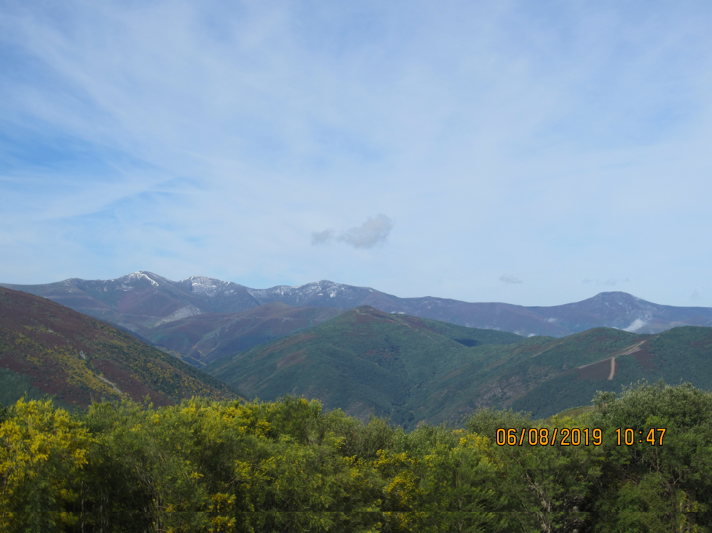Rethinking the 'know-how' and the 'being'
CEESP News: by Sandra Pilar Sanchez, Economist, Manager in International Business, Maître ès sciences, M. Sc
Living in times when much transformation is urgently needed, at many levels, this article highlights relevant information from research on biodiversity, business, and circular economy. Concrete actions require gradual behavior changes at the political, economic, and social levels. This opens multiple opportunities for leadership and strategic thinking out of the box.

Photo: Sandra Sanchez
Mountain landscape, Spain. Photo by Sandra Sanchez
The traditional way to do business doesn’t tackle the most present and urgent challenges we are facing. The Global Biodiversity Outlook 4 stated “While natural resources are being used much more efficiently to produce goods and services, this progress is overwhelmed by our greatly increased total levels of consumption. It is unlikely that ecosystems can be kept within safe ecological limits given current patterns of consumption”. *
Paving the way of a new development - in which nature is at the core - requires a paradigm shift toward a wise understanding and use of biodiversity by all actors of society. This includes innovating decision-making strategies, involving local communities and business sector, integrating the values of biodiversity into policy, changes in economic incentives, and addressing shifts in consumption patterns. Additionally, transforming the financial and the policy system will benefit businesses, as well as society.
As outlined in a report by Business for Nature, the loss of nature has concrete - and immediate - costs and impacts for businesses**:
- Operational risks;
- Supply chain continuity, predictability and resilience;
- Liability risks;
- And regulatory, reputational, market and financial risks
In 2018, Nicholas Stern stated that “the challenge is to accelerate action; the next two decades will be decisive… they will determine if we are to suffer severe and irreversible damage to lives, livelihoods and the natural world or if we follow a much more attractive path of sustainable and inclusive development and growth”[1].
The Global Risks Report 2020 highlights that the top five global risks in terms of likelihood are all environmental[2]. The World Economic Forum launched the new Nature Economy (NNE) series in January 2020. Its first report, named Nature Risk Rising underlines[3]:
- For decades, the economic growth has been based on the use and degradation of nature. The data about the destruction of species, the loss of natural habitats and the 1 million species at the risk of extinction in the coming years is alarming.
- Dependency of business on nature, fallout of business impacts on nature and impacts of nature loss on society, are cited as the three main ways in which destruction of biodiversity and ecosystems creates risks for business.
- Need to increase knowledge, analysis and comprehension about how nature loss affects business and what practical steps businesses can take towards addressing nature loss.
- More than half of the world’s total Gross Domestic Product (GDP) depend on nature and its services. The three largest sectors in the economy that are highly dependent on nature generate close to USD 8 trillion of GVA: construction, agriculture, food and beverages.
- New business models and strategies are needed. It is important to better value nature contributions in supply chains, including accounting for natural capital and the costs of ecosystems degradation within economic development.
So, the question is how can we do better and address the detrimental impacts on nature, development and society?
Actually there is an urgent call for the integration of a non-linear economy approach namely the circular economy approach. McDonough W et al (2002)[4] explained the principles of it: first, at its core, a circular economy aims to design out waste. Waste does not exist: products are designed and optimized for a cycle of disassembly and reuse; second, circularity introduces a strict differentiation between consumable and durable components of a product; and third, the energy required to fuel this cycle should be renewable by nature, to decrease resource dependence and increase systems resilience.
The circular economy has seen a significant increase in interest from all sectors of society. Circle Economy, a non-profit organization, mapped some principles:
DISRUPT states the elements of a circular economy[5]: Design for the future, Incorporate digital technology, Sustain and preserve what’s already there, Rethink the business model, Use waste as a resource, Prioritize regenerative resources, Team up to create joint value.
Additionally, The Circularity Gap Reporting Initiative illustrates the state of the world’s economy in terms of the transition to a global circularity. The 2020 report shows[6]:
- The world is just 8.6% circular, which is explained by high rates of extraction; on going stock buildup; and, increasing levels of end-of use processing and cycling.
- The need of transformative and correctional solutions
- In the actual context, all countries are developing countries
- At the national level, in 2019 Colombia launched its national circular economy strategy, the first of its kind in Latin America.
- “The first circularity Gap report of a country was created for Austria This report estimates the improvements to be gained from four courses of action: Shifting from fossil fuels to renewable resources (boosting circularity to 9.9%); Recycling of all recyclable waste (18.8%); Maintaining current buildings and infrastructure by sourcing all construction materials from demolition of old building stocks (11.6%); Prioritizing imports with a higher proportion of secondary content (20.1%). Combined, these four actions can boost Austria’s circularity rate to an estimated 37.4%”.
Another research about the circular business model on the construction sector highlights[7] the importance to take into consideration a long-term thinking, design for deconstruction, innovation, flexibility vs durability, utilise new models of production and consumption, and collaboration.
Business for nature[8] recommends measures such as: Adopting target to reverse nature loss; aligning, integrating and enforcing policies for nature, people and climate; valuing and embedding nature in decision making and disclosure; reforming subsidies and incentive mechanisms; joining forces for nature and empowering everyone to act. Additionally, Business for Nature highlights some opportunities for business such as: long-term viability of business models; cost savings; increases in operational efficiency; increased market shares; access to new markets, products and services; predictable and stable supply chains; better relationships with stakeholders and customers.
Some private sector companies are using science indicators into their transition to a low-carbon economy[9].
Worldwide, there is a growing awareness to protect nature using environmental law. Experts members of the Harmony with Nature Knowledge Network underline that the “Recognition in law of the inherent rights of Nature brings the debate on environmental protection within the bounds of what is responsible and sustainable. Changing the perception of Nature from being seen as merely property under the law to being recognized as possessing legal personhood, and holding inherent rights as healthy, natural ecosystems, is key to preserving and conserving it”.[10]
In conclusion, current challenges demand the ignition of an innovator approach of development in which nature is valued in a more holistic manner, and in which the contribution to the preservation, restoration and conservation of nature become the most important indicator to the market and non-market valuation of products and services, the development and well-being of all species.
[1] Nicholas Stern, 2018, The economic reasons to act on climate change and to act immediately. Available at: http://www.lse.ac.uk/GranthamInstitute/wp-content/uploads/2018/07/The-Economic-Reasons-to-Act-on-Climate-Change.pdf
[2] https://www.weforum.org/reports/the-global-risks-report-2020
[3] http://www3.weforum.org/docs/WEF_New_Nature_Economy_Report_2020.pdf
[4] McDonough, W., Braungart, M., Cradle to Cradle: Remaking the Way We Make Things, New York: North Point Press, 2002
[5]https://www.circle-economy.com/circular-economy/7-key-elements
[6]https://www.circularity-gap.world/2020
[7] https://www.arup.com/perspectives/publications/research/section/circular-business-models-for-the-built-environment
[8] https://www.businessfornature.org/policy
[9] https://sciencebasedtargets.org/companies-taking-action/
[10] https://undocs.org/pdf?symbol=en/A/72/175
* https://www.cbd.int/gbo/gbo4/gbo4-summary-en.pdf
** https://www.businessfornature.org/businesscase
About the author
 Photo: Sandra Sanchez
Photo: Sandra Sanchez
She holds a masters degree in Economics, a bachelor’s degree in Management in international business and a bachelor’s degree in Economics. She is member of CEESP and the CC-IUCN. She has more than 15 years of working experience in the private sector and not profit sector in Canada, United States and Colombia.



